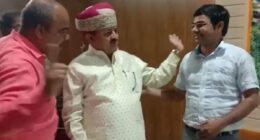A convicted South African murderer who killed dozens of black men during apartheid has told the BBC that the police sanctioned his violence. Louis van Schoor claims others should share the blame for the murders he committed as a security guard. However, in conversations with BBC Africa Eye over the past four years, he has revealed disturbing details that raise serious questions about his early release from prison.
Standing in the bedroom of a killer, your eyes naturally focus on the details.
Van Schoor’s bed is immaculately tidy, the duvet so flat it appears ironed. The air is thick with the smell of cigarettes, their stubs piled high in an ashtray. Strips of sticky paper hang from the ceiling, writhing with trapped and dying flies.
The so-called “Apartheid Killer” has lost his teeth and his health is deteriorating. After suffering a heart attack, both his legs were recently amputated, leaving him in a wheelchair with painful scars. When his surgeon performed the procedure, Van Schoor requested an epidural instead of a general anaesthetic so he could watch them remove his legs.
“I was curious,” he said, chuckling. “I saw them cutting… they sawed through the bone.”
In his conversation with the BBC World Service, Van Schoor aimed to convince us that he is “not the monster that people say I am.” However, his eager description of his legs being removed did little to soften his image.
During a three-year period in the 1980s, under South Africa’s racist apartheid system-which imposed a strict hierarchy privileging white South Africans-Van Schoor shot and killed at least 39 people. All of his victims were black, with the youngest being just 12 years old. The killings occurred in East London, a city in South Africa’s windswept Eastern Cape.
At the time, Van Schoor was a security guard with a contract to protect up to 70% of white-owned businesses, including restaurants, shops, factories, and schools. He has long maintained that everyone he killed was a “criminal” caught red-handed breaking into these buildings.
“He was a kind of vigilante killer. He was a Dirty Harry character,” says Isa Jacobson, a South African journalist and filmmaker, who has spent 20 years investigating Van Schoor’s case.
“These were intruders who were, in a lot of cases, pretty desperate. Digging through bins, maybe stealing some food… petty criminals.”
Van Schoor’s sometimes several in a single night-instilled terror in the black community of East London. Stories circulated about a bearded man, nicknamed “whiskers” in the Xhosa language, who made people disappear at night. However, his shootings were not secretive.
Between 1986 and 1989, Van Schoor reported every killing to the police himself. The release of anti-apartheid leader Nelson Mandela in 1990 marked the end of this impunity. As change swept across South Africa, pressure from activists and journalists led to Van Schoor’s arrest in 1991.
Van Schoor’s trial became one of the largest murder trials in South African history, involving dozens of witnesses and thousands of pages of forensic evidence. However, the case against him largely collapsed in court. At the time, much of the apartheid system’s apparatus was still entrenched within the judiciary. Despite killing at least 39 people, he was only convicted of seven murders and served just 12 years in prison.
His other 32 killings remain classified as “justifiable homicides” by the police. Apartheid-era laws permitted lethal force against intruders if they resisted arrest or fled once caught. Van Schoor heavily relied on this defense, claiming his victims were fleeing when he killed them.
Post a comment (This story has not been edited by NDTV staff and is auto-generated from a syndicated feed.)


















